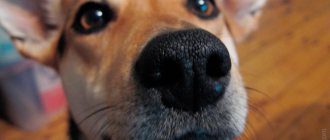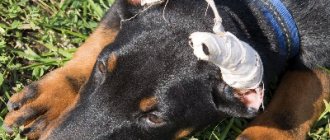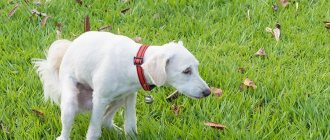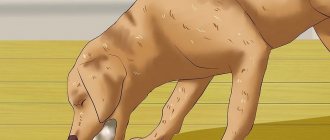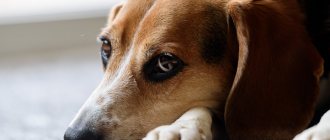Norm or pathology
Mucus is present in feces in any case, because it is regularly produced in small quantities by the intestinal glands.
This process is intended by nature and is necessary for:
protecting the walls from mechanical damage that can be caused by undigested food or foreign objects passing with feces;- neutralization of pathogenic microflora that causes intestinal diseases;
- preventing the negative effects of toxic components present in feces;
- normal passage of feces in the colon.
When should you not worry?
If there is a small amount of jelly-like oily mucus in the stool, this is normal. This means that the intestines work stably, its walls are provided with good lubrication, and the pet will not have constipation.
When a four-legged “household member” behaves actively, eats well, and does not whine, the mucus present in his feces should not cause concern.
Signs you shouldn't ignore
If mucus comes out of the anus in copious amounts, you should look for the cause of this pathology.
Increased secretion of jelly-like secretion indicates that the body requires additional protection. Such a reaction to pathology is accompanied not only by a large amount of mucus, but also by a change in its shade.
Slime color
| Hue | What influences |
| Yellow | Polyps could form in the intestines. Another reason is the irritating effect of medications taken the day before. |
| Green | Pathogenic microbes have become active in the gastrointestinal tract |
| Pink | Reason to suspect a purulent inflammatory process occurring in the intestines |
| Clear stool | A sign of serious damage to distant parts of the intestine |
Normally, a dog’s stool is brown, so the appearance of other shades in bowel movements is a reason to contact a veterinary clinic. This is especially necessary when other negative signs are present - vomiting, diarrhea, severe pain.
Reasons for the development of pathology
A small amount of mucus always appears during bowel movements. This is a normal physiological phenomenon.
Mucus is produced by the intestinal glands. It is necessary in the body to protect the intestines from the effects of feces. Mucus in the large intestine is necessary to facilitate the passage of stool to the exit.
Important! If there is no mucus in the intestines, this can lead to constipation.
Physiological
Mucus in a dog's stool may indicate a feeding disorder. This phenomenon is often observed in the following cases:
- With mixed feeding. If there is a sudden change in the pet’s diet from dry dog food to natural food. This can cause negative reactions from the body.
- Purchasing low-quality feed. Economy class dry products contain a large amount of dyes and preservatives.
- Failure to comply with feeding standards, frequent overeating in animals.
Hypothermia, drinking bad water, and frequent exposure to stressful situations can affect the condition of a dog’s feces.
Mucus in the feces of pets may appear during a sudden transition from one diet to another.
Pathological
In a dog, stool with mucus can be the result of pathological irritation of the intestinal walls. A jelly-like secretion begins to be released as a protective reaction of the body.
Depending on the type of disease, the color of the substance may vary. If the mucus is green in color with an unpleasant odor, this indicates the release of pathogenic microflora.
A yellow tint indicates intestinal damage from drugs. If a pink jelly-like substance is released in the stool, this means that purulent inflammation is occurring in the intestines.
Jelly-like stool in a dog can be observed for the following reasons:
- development of food allergies;
- diseases of the rectum;
- colitis;
- parasite infection;
- dysbiosis.
Colitis
Colitis refers to an inflammatory process that occurs in the large intestine. Its causative agents are bacteria that are found in the dog’s gastrointestinal tract. As soon as they begin to actively multiply, inflammation occurs in the stomach, which causes mucus to appear in the stool.
The disease is accompanied by severe pain; the dog often has the urge to defecate, which does not lead to results. This is one of the main symptoms of colitis. All attempts to poop cause pain for the pet. Blood stains remain in the place where the dog wanted to go to the toilet.
Important! Often, pet owners confuse colitis with constipation and try to take measures to treat it at home. This is a big mistake, which leads to the transition of colitis to an advanced stage. The animal additionally vomits.
The veterinarian will be able to detect colitis by palpation. Touching the rectum causes severe pain. To make an accurate diagnosis, an x-ray of the stomach is prescribed.
Colitis is a common cause of mucus discharge during dog bowel movements.
Dysbacteriosis
Disturbance of the microflora in the intestines is called dysbiosis. The microflora can either decrease or disappear completely under the influence of unfavorable factors.
The causes of dysbacteriosis are:
- past illnesses;
- the use of medications, most often the disease is provoked by taking antibiotics.
The disease is additionally accompanied by decreased appetite, lethargy and apathy on the part of the pet. In this regard, you should not delay treatment for too long.
Infection with worms
This is the most common disease in animals of all breeds. At risk are both small dogs such as Spitz, Yorkie, Chihuahua, and huskies, Labradors, and spaniels. Parasites can live in a dog’s body for a long time without showing themselves. The only option to protect your pet from pathology is to carry out deworming several times a year.
If your pet is infected with parasites, the following symptoms will occur:
- weight loss;
- lethargy;
- frequent vomiting.
When parasites die, they exit the body through the anus along with feces in the form of a jelly-like mass. Puppy poops mucus while deworming.
Dogs of all breeds are at high risk of contracting parasites.
Piroplasmosis
If your dog poops with mucus, this may indicate the development of a disease caused by the bite of an infected tick.
The animal develops shortness of breath and a lethargic state. He may pass orange or yellow colored stool. The animal's temperature rises and it often vomits. Symptoms will increase depending on the severity of the disease.
Important ! If you do not begin to treat the animal, the dog dies within a few days after the bite.
Why does mucus appear in animal feces?
It is necessary to accurately determine the causes of excessive secretion. There are several factors, all of which require a quick response.
Causes of excessive mucus production
| Problem | Description |
| Colitis | The disease affects the large intestine and is manifested by inflammation of its lining. Along with a large amount of mucus, blood also comes out during defecation. Other signs of the disease:
|
| Enterocolitis | In addition to the large intestine, inflammation also affects the small intestine. Main features:
The dog may itch in the anus, so it tries to relieve the itching by rubbing its butt on the floor |
| Gastritis | Inflammation affected the gastric mucosa. Having noticed the dark color of the stool and the abundance of secretions in it, check for the presence of other symptoms:
If the large intestine is also inflamed, they speak of gastroenteritis. It is accompanied by an unpleasant odor from the mouth, frequent belching, flatulence, alternating constipation with diarrhea |
| Stomach ulcer | The symptoms are very similar to gastritis, but in the vomit, in addition to mucus and bile, there is also blood. The stool becomes black, the pain is localized in the left side of the peritoneum. The dog has no appetite at all |
| Dysbacteriosis | Reluctance to eat is also observed with this pathology. Additional signs of the disease:
|
| Worm infestations | White worms can sometimes be seen in slimy, liquid stools. The presence of helminths is also judged by the following signs:
|
Since all problems that provoke an abundance of mucus are associated with the digestive system, the symptoms of the diseases are similar. To prescribe the correct treatment for your animal, you will need a preliminary examination.
Mucus in the stool (diarrhea with mucus) in dogs
Mucus in a dog's stool is a dangerous symptom that worries many owners, and for good reason - it never occurs on its own.
Typically, such a clinical sign indicates serious disturbances in the functioning of the stomach, inflammatory processes, damage to its walls and mucous membrane. You should know that problems that cause blood in the stool cannot disappear on their own, which means that after detecting such a symptom, your pet should be taken to see a veterinarian as soon as possible.
Diagnostic methods
You cannot diagnose and treat a dog on your own . At the slightest suspicion of problems with the gastrointestinal tract, it is necessary to take the pet to a veterinary clinic, where a number of diagnostic measures will be carried out.
Visual inspection
The doctor examines the animal, checking the condition of its skin and fur. Be sure to look into the mouth to examine the coating on the tongue and determine the amber of the breath.
A palpation examination of the peritoneum is performed to identify the location of pain, as well as the presence of gases.
Having compared the results with the information received from the dog owner, they move on to the next stage.
Stool examination
Stool analysis (both visual and laboratory) allows you to more accurately diagnose the problem. Fecal masses are studied by color, consistency, and the presence of helminths and pathogens in them.
Other methods
To get a clearer picture, an additional blood test (biochemical and general) is taken. A hardware examination of ultrasound and x-ray of the peritoneum is prescribed.
When is a colonoscopy performed?
This procedure allows you to take pieces of tissue from affected areas of internal organs for examination.
The procedure is prescribed for frequently recurring diarrhea or difficulties with defecation, a sharp decrease in the animal’s weight, and characteristic bleeding.
Not every clinic uses such diagnostics, since anesthesia is required. If the dog is in serious condition, the procedure is dangerous.
Diagnosis and treatment
Mucus in the stool can indicate the presence of a number of diseases. Therefore, a dog with this disorder requires comprehensive diagnosis and treatment.
Progress of diagnostic measures
It is mandatory to conduct an external examination of the dog and interview the owner about the conditions of feeding and care.
A stool analysis provides a lot of information. With its help, the presence or absence of helminths in the intestines, the content of latent blood in the stool is revealed, and the inflammatory process is diagnosed. If colon tumors are suspected, a colonoscopy or MRI using a contrast agent is performed.
Before making a diagnosis, the doctor analyzes the clinical picture. In this case, the entire complex of symptoms is considered. Their combination, the predominance of some over others, and the brightness of their manifestation are taken into account:
- Inflammatory bowel diseases are characterized by an acute course, watery stools, and rapid onset of general symptoms.
- Anal fissures are always accompanied by severe pain. Defecation occurs with the release of a small amount of scarlet blood.
- Colitis of autoimmune etiology is usually characterized by strong urge in the absence of stool. During the urge, mucus of a characteristic greenish hue is released.
- In cases of pathology of the body's enzymatic system, feces usually contain remnants of undigested food.
- Helminth infections are characterized by severe itching of the anus, pain in the abdominal area, nausea, and abdominal enlargement.
Treatment
Treatment tactics differ in each case. The veterinarian-gastroenterologist, based on the results of the diagnostics, selects a regimen. Then the doctor makes appointments, monitors the treatment process, and, if necessary, makes adjustments.
- Food allergies are treated by strict adherence to a diet and the use of antihistamines. The allergen, the food or product that caused the allergic reaction, is excluded from the diet. Read more about dog food allergies.
- In case of dysbacteriosis, treatment should be comprehensive. To remove toxins and pathogenic microflora, sorbents are prescribed and infusion therapy is carried out. Then probiotics and prebiotics are prescribed to populate the intestines with beneficial microflora. Immunomodulator drugs are prescribed to maintain the body's defenses.
- For colitis, therapeutic fasting is recommended. Upon completion (after 2 days), improvement occurs (normal stool is restored). Then a therapeutic diet is developed for the dog. Fatty and carbohydrate foods are excluded. Medicines prescribed include drugs that eliminate diarrhea (Loperamide) and antimicrobial agents (Metronidazole). To restore water and electrolyte balance, droppers with potassium chloride are prescribed.
- Helminthiasis is treated by prescribing anthelmintic drugs. The dog is given special medications in a dosage appropriate to its age and size. After deworming, it is necessary to remove dead helminths from the body as soon as possible to eliminate the possibility of poisoning. To do this, it is recommended to give the dog a laxative or give an enema.
- When selecting a treatment regimen for gastroenteritis, attention is paid to its nature. Viral intestinal infections are treated with antiviral drugs. If the cause of the disease is poisoning of the body, then gastric lavage is done and antidotes are used. If gastroenteritis is a reaction to the use of potent drugs, then they are discontinued. If it is impossible to do this, reduce the dosage and prescribe gastroprotectors.
To stop severe diarrhea with blood and mucus, strengthening drugs are prescribed and the body is dehydrated.
Treatment options
After conducting an examination and identifying the reasons that influenced the presence of copious mucus secretions, the veterinarian selects the appropriate treatment regimen.
| Disease | Therapy |
| Colitis | First, the pet is transferred to therapeutic fasting for 2 days. As soon as the stool returns to normal, an appropriate diet is selected, excluding carbohydrates and fatty foods. To restore hydrobalance, the dog is placed under a potassium chloride drip. The antimicrobial drug Metronidazole is prescribed for medications; Loperamide is prescribed to eliminate diarrhea. |
| Gastroenteritis | If the problem is related to poisoning, then gastric lavage and administration of an antidote are prescribed. When the disease is provoked by previously taken medications, they are discontinued or the dose is reduced (drug replacement is possible). For viral etiology, the dog is treated with appropriate medications |
| Gastritis | The animal is prescribed anti-diarrhea and vomiting medications. Antispasmodics, antacids, glucocorticoids and antibiotics are used. The pet is given water for the first day, then put on a diet: pureed mucous soups, minced lean meat |
| Dysbacteriosis | Therapy includes immunostimulants, antihistamines and probiotics. They introduce a strict diet, excluding bones, fatty meat, sausages and smoked meats from the menu. Raw vegetables are also prohibited. |
| Infestations | For deworming, special drugs are used: Dirofen, Drontal, Milbemax, Prazitel, etc. |
If your pet is diagnosed with a stomach ulcer, surgical intervention is essential.
In parallel, drug therapy is carried out using drugs that suppress the fermentation of hydrochloric acid, relieve gagging and eliminate inflammation. You will also need enveloping and painkillers, antispasmodics, and antibiotics.
Treatment
If you notice that your dog is vomiting mucus
and the amount of mucus in the stool has increased, then it is necessary to urgently contact a veterinarian, since only he can prescribe the correct treatment.
Please note that the puppy's mucus
- this is a more dangerous symptom than in an adult animal, since the growing body cannot yet fight all diseases well.
If your puppy has diarrhea due to mucus
, you must urgently call our veterinary center and, while waiting for the doctor, give the baby plenty of water so as not to provoke dehydration.
Preventive actions
Health problems are easier to avoid than to fix them later.
It is especially important to take control of your puppy's bowel movements. Babies have not yet fully developed their digestive system; they have a weak immune system that is unable to resist serious diseases.
Prevention of excess secretion in the feces of dogs includes the following measures:
high-quality, balanced nutrition;- compliance with hygiene rules;
- visit the veterinarian once every six months;
- isolation from stray animals;
- choice of places for walking.
High-quality food for a dog is a crucial moment. If feeding is provided with natural products, it should include only fresh food.
Poisoning leads to gastrointestinal problems. When food is present in the diet, only premium brands are chosen, since they contain less artificial additives.
Deworming is carried out regularly to completely eliminate the appearance of infestations.
Twice a year the dog is shown to the veterinarian. This allows hidden problems to be identified in a timely manner.
Walking in the fresh air with mandatory outdoor games strengthens your pet’s immunity well. But it is necessary to ensure that the dog does not come into contact with stray animals and does not pick up anything from the ground .
Diarrhea and vomiting with mucus
The main cause of diarrhea with mucus in a puppy and an adult dog is poisoning. Sour food enters the digestive tract, causing fermentation processes. The body tries to get rid of it faster. Therefore, the stool becomes liquid, with mucous impurities from the intestines. Diarrhea also occurs due to:
Colitis treatment regimen
Once the veterinarian determines the diagnosis, the treatment procedure begins. Therapy depends on the cause of the presence of mucus in the stool.
Symptoms and treatment of colitis in dogs are closely related, since therapy is purely symptomatic. Additionally, the animal’s nutrition is adjusted. Veterinarians often prescribe Sulfasalazine and Loperamide. Suppositories, enemas and rectal suppositories can also be prescribed as additional methods of therapy. Treatment of particularly severe cases involves taking corticosteroids and immunosuppressive drugs.
Treatment of dysbiosis in dogs involves complex therapy. Drugs are prescribed that have a beneficial effect on the intestinal microflora and populate it with necessary microorganisms. Taking probiotics for dogs with this disease is a prerequisite for treatment. But they are not the only ones included in complex therapy.
In addition to probiotics, dogs are given homeopathic medications to cleanse their intestines.

